- 1Shandong University of Science and Technology Library, Qingdao, China
- 2College of Earth Sciences & Engineering, Shandong University of Science and Technology, Qingdao, China
- 3Key Laboratory for the Study of Focused Magmatism and Giant Ore Deposits, Xi’an Center of Geological Survey (Northwest China Center of Geoscience Innovation), China Geological Survey, Xi’an, China
Nowadays, the Khondalite Belt is considered to be a typical continent-continent collisional belt, formed by the collision of the Yinshan Block and the Ordos Block at 1.95–1.85 Ga. However, the pre-collisional tectonic setting and crustal evolutionary history of the Khondalite Belt are poorly constrained. In order to better understand the crustal evolution of the Khondalite Belt, zircon Lu-Hf isotopes and trace elements have been studied based on the published zircon U-Pb age data of the meta-mafic and felsic rock assemblages from the Daqingshan Complex. The zircon U-Pb dating results indicate that the meta-mafic and felsic rock assemblages yield crystallization ages ranging from 2.47 to 2.39 Ga, with metamorphic ages between 1.91 and 1.83 Ga. The zircon Hf isotopic data from meta-mafic rocks have εHf(t) values of −0.3 to +9.7. The depleted-mantle two-stage zircon Hf model ages range from 2,951 to 2,324 Ma and are mainly concentrated at 2.8 to 2.6 Ga, indicating that the primary magma originated from partial melting of the depleted lithospheric mantle. The zircon Hf isotopic data from felsic rocks have εHf(t) values of +2.4 to +9.1, indicating that these samples were derived from partial melting of juvenile crustal materials. In addition, the trace element characteristics of the zircons indicate that they were formed in the continental arc-related/orogenic tectonic setting. Combined with previous studies, it is proposed that the meta-mafic and felsic rock assemblages within the Daqingshan Complex represent the magmatic product formed by the early Paleoproterozoic continental magmatic arcs along the southern margin of Yinshan Block. In summary, it can be inferred that Khondalite Belt experienced long-lived arc-continental accretion along the southern margin of the Yinshan Block during the late Neoarchean to Paleoproterozoic, subsequently followed by collision between Yinshan and Ordos Blocks and merged into an integrated Western Block at ca. 1.95–1.85 Ga.
1 Introduction
In the past 2 decades, three Paleoproterozoic linear tectonic belts were identified in the western, central, and eastern parts of the North China Craton (NCC), respectively, named the Khondalite Belt (KB)”, “Trans-North China Orogen (TNCO)” and “Jiao-Liao-Ji Belt (JLJB)” (Figure 1; Zhao et al., 1998; Zhao et al., 2000; Zhao et al., 2001; Zhao et al., 2005; Zhang et al., 2007; Zhang et al., 2009; Zhang et al., 2012; Yin et al., 2009; 2011; Wang et al., 2023; Wang et al., 2024; Wang et al., 2025; Zhao et al., 2024). The Paleoproterozoic KB is generally considered as a collisional orogeny created by the amalgamation between the Yinshan Block and the Ordos Block at ca. 1.95 Ga, which has resulted in the formation of the Western Block in the NCC (Figure 1; Zhao et al., 2005). It is worth noting that the KB has been extensively studied in terms of structural investigations, metamorphism, geochemistry, and geochronology, however, the crustal evolution and tectonic setting remain unclear or debatable. Kusky and Li (2003) regarded the KB as part of a Paleoproterozoic orogen named the Inner Mongolia-North Hebei Orogen, which they assumed to have formed by collision between the northern margin of the NCC and an exotic arc terrane at ca. 2.3 Ga, and later collided with the Columbia supercontinent at 1.92–1.85 Ga. Zhai et al. (2010) suggested that the KB was similar to the JLJB and also underwent the initial rifting to form incipient oceanic basins followed by the processes of subduction and collision. Santosh et al. (2013) proposed that the high-grade metamorphism younging from ca. 1.95 Ga in the western segment to ca. 1.92 Ga in the eastern segment of the KB, indicates a scissor-like closure of oblique collision between the Yinshan and Ordos Blocks. In recent years, some researchers proposed that the KB underwent long-lived arc-continental accretion along the southern margin of the Yinshan Block during 2.55–2.30 Ga, through the formation resulting from a continent-continent collision the Yinshan and Ordos Block in the Western Block at 1.95–1.85 Ga (Liu J. H. et al., 2017; Wang et al., 2018; Wang et al., 2020; Wang et al., 2021; Wang et al., 2022). Li et al. (2022) established a prolonged magmatic-metamorphic evolution of the KB from subduction to collision, involving ca. 2.3–2.0 Ga subduction-related arc magmatism, ca. 1.95 Ga syn-collisional high-pressure high-temperature crustal anatexis, and ca. 1.92 Ga post-collisional magmatism and synchronous ultrahigh temperature metamorphism.
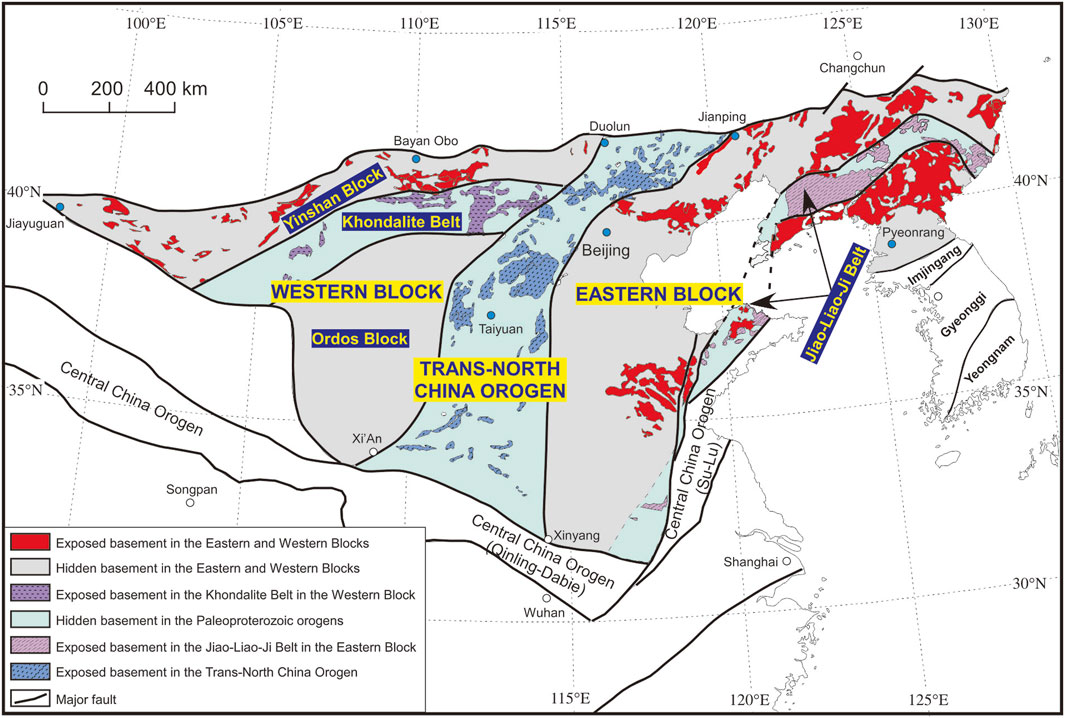
Figure 1. Tectonic subdivision of the North China Craton proposed by Zhao et al. (1998), Zhao et al. (2001), Zhao et al. (2005), showing spatial distribution of basement rocks in the Neoarchean Eastern and Western Blocks, as well as the intervened Paleoproterozoic Trans-North China Orogen.
In the KB, the 2.47–2.39 Ga meta-mafic and felsic rock assemblages from the Daqingshan Complex have only been studied in geochronology (Wang et al., 2021). However, their Hf isotopic and trace element compositions are poorly constrained. It has hindered further understanding of the geodynamic process of the Paleoproterozoic magmatism, which may have played a significant role in the pre-collisional tectonic evolution of the KB. To resolve the crustal evolution and tectonic setting of the KB, we present detailed petrological, zircon Hf isotopic and trace element compositions on the meta-mafic and felsic rock assemblages recognized in the Daqingshan Complex in the northern margin of the KB. Combined with previous study of these assemblages, the results of this study will place important constraints on the crustal evolution and geodynamic process of the KB.
2 Geological setting and sample descriptions
The Khondalite Belt, also named the Fengzhen Orogenic Belt or Inner Mongolia Suture Zone (Santosh et al., 2010), is a ∼1,000 km long east-west-trending belt that extends from the Helanshan-Qianlishan Complex in the west, through the Daqingshan-Wulashan Complex in the middle, to the Jining Complex in the east (Figure 2; Zhao et al., 2005; Guo et al., 2005; Wang et al., 2018; Wang et al., 2020; Wang et al., 2021; Wang et al., 2022).
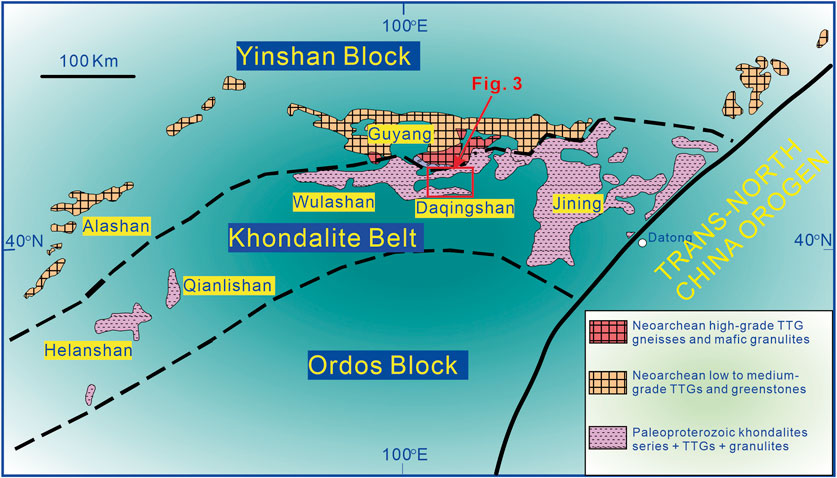
Figure 2. Schematic tectonic division of the Paleoproterozoic Khondalite Belt in the Western Block (revised after Zhao et al., 2002; Zhao et al., 2005).
Previous studies have shown that these complexes are mainly composed of low-to high grade metamorphosed supracrustal rocks (e.g., biotite plagioclase gneiss, garnet quartzite, marble, calc-silicate rock, and graphite gneiss) and TTG gneisses (tonalite-trondhjemite-granodiorite), which are collectively called “Khondalites” or “Khondalite Series” in the Chinese literature (Lu et al., 1996). In recent years, SHRIMP and LA-ICP-MS zircon U-Pb dating of the “Khondalite Series” indicates that they were deposited at 2.4–2.0 Ga, and underwent 1.95–1.85 Ga metamorphism (Zhao et al., 2002; Zhao et al., 2005; Xia et al., 2006; Xia et al., 2008; Xia et al., 2009; Dan et al., 2012; Jiao et al., 2013; Wang et al., 2018; Wang et al., 2020; Wang et al., 2021; Wang et al., 2022). Furthermore, many studies show that the protoliths of the “Khondalite Series” were deposited in the passive continental margin setting (Zhao et al., 2002; Zhao et al., 2005).
The Daqingshan Complex is in the central part of the KB (Figure 2). The Daqingshan Complex is mainly composed of Paleoproterozoic Erdaowa and Mesoproterozoic Majiadian Groups (Figure 3). The Erdaowa Group is dominated by greenschist to amphibolite facies metamorphosed volcanic-sedimentary rock series (Figure 3; Wang et al., 2018; Wang et al., 2020; Wang et al., 2021; Wang et al., 2022), and the Mesoproterozoic Majiadian Group is composed of low-grade metamorphic rocks such as slates, phyllites, and sandstones (Figure 3; Jiao et al., 2015). Recently, Wang et al. (2018), Wang et al. (2020) proposed that the low-grade metamorphic rocks of the Erdaowa Group formed at 2.47 Ga, with metamorphic ages of 1.95 to 1.85 Ga, and their igneous protoliths have an affinity to continental margin arcs. In addition, some late Archean-Paleoproterozoic TTG gneisses and monzogranites are in tectonic contact with the Erdaowa Group and experienced a metamorphic event at 1.95–1.85 Ga (Liu P. H. et al., 2017; Wang et al., 2020).
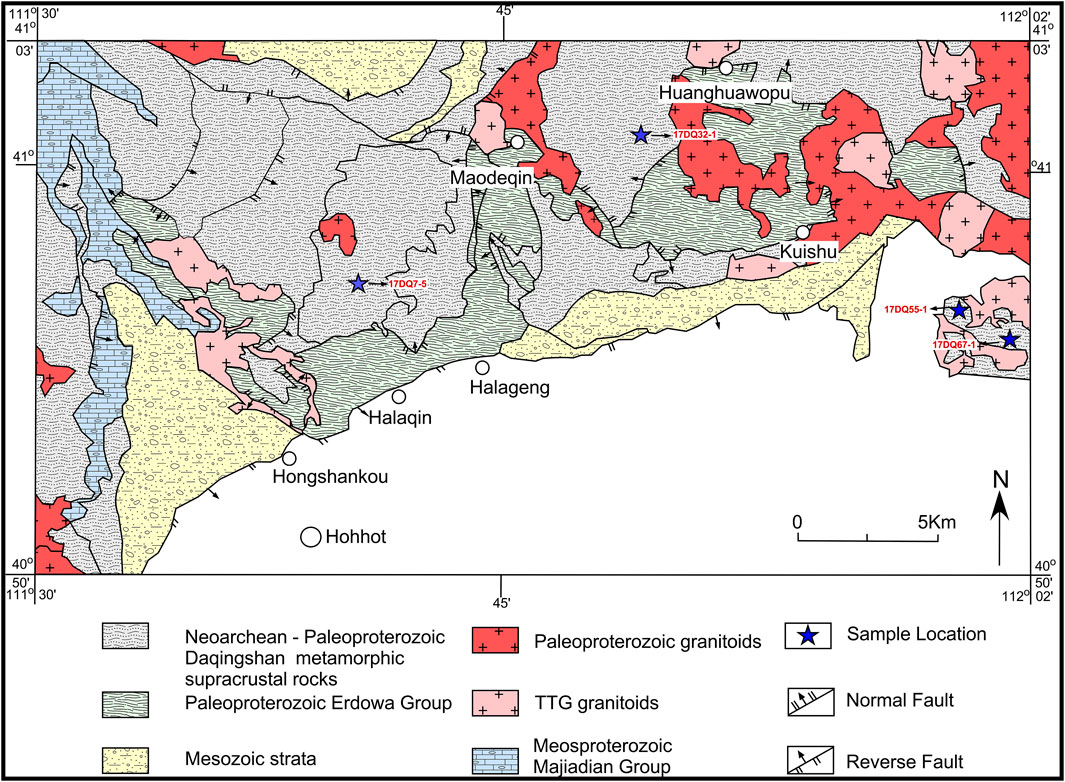
Figure 3. Simplified geological map of the Daqingshan Complex showing sampling locations (Modified after Wang et al., 2018).
In this study, we conduct a comprehensive study of representative meta-mafic and felsic rock assemblages from the Daqingshan Complex. The meta-mafic and felsic rock assemblages are composed of two types of rock units. The meta-mafic rock is mainly composed of plagioclase amphibolite, which shows a fine-medium grain crystalloblastic texture and massive structure (Figure 4a). Petrographic observations indicate that plagioclase amphibolite is mainly composed of amphibole (35%–45%), plagioclase (30%–35%), biotite (10%–15%), and other accessory minerals, such as epidote, titanite and pyrite (∼5% in total) (Figures 4b,c). The felsic rock mainly consists of biotite plagiogneiss, which shows a medium or fine-grained crystalloblastic structure and gneissic structure (Figure 4d). The biotite plagiogneiss is mainly composed of plagioclase (±40%), hornblende (±25%), quartz (±20%), and biotite (±15%) (Figures 4e,f).
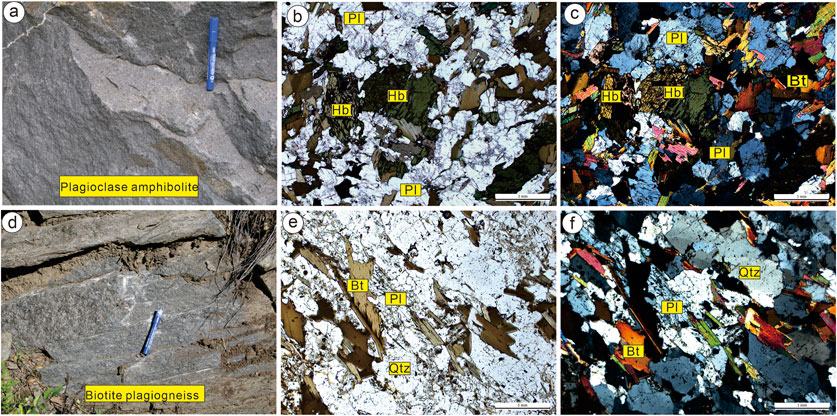
Figure 4. Representative outcrop and microscopic images of the meta-mafic and felsic rock assemblages in the Daqingshan Complex. (a) Field geological characteristics of the plagioclase amphibolite. (b,c) Microscopic images showed mineral composition of the plagioclase amphibolite. (d) Field geological characteristics of the biotite plagiogneiss. (e,f) Microscopic images showed mineral composition of the biotite plagiogneiss (Hbl-hornblende, Pl-Plagioclase, Bt-biotite, Qz-quartz).
3 Analytical methods
Cathodoluminescence (CL) images and LA-ICP-MS U-Pb dating of the studied zircons have been published in Wang et al. (2021). Based on the zircon dating results, the same sites for Lu-Hf isotope analyses on the cores of the zircons were selected using a Neptune Plus (MC-ICP-MS) instrument equipped with a New Wave UP21 LA system at the Chengpu Geological Testing Co. Ltd, Langfang, China. The beam diameter of the spot was 44 μm, and the laser repetition rate was 8 Hz at 6 J/cm2 for 27 s. The detailed analytical procedures and interference corrections used were similar to those described by Wu et al. (2007). The εHf(t) values were calculated based on the chondrite values of 176Hf/177Hf (0.282772) and 176Lu/177Hf (0.0332) ratios.
4 Analytical results
In cathodoluminescence (CL) images, most zircon grains from the meta-mafic and felsic rock assemblages (17DQ7-5, 17DQ32-1, 17DQ55-1, 17DQ67-1) a typical core-rim structure, characterized by oscillating zoning in the core and homogeneous structures in the rim with bright luminescence (Figure 5). Zircon U-Pb dating results showed that the protoliths of meta-mafic and felsic rock assemblages yield crystallization ages ranging from 2.47 to 2.39 Ga and metamorphic ages of 1.91 to 1.83 Ga (Supplementary Table S1; Figure 6). Lu-Hf isotopic compositions by the zircons from the meta-mafic and felsic rock assemblages have been tested in this study (Supplementary Table S2).
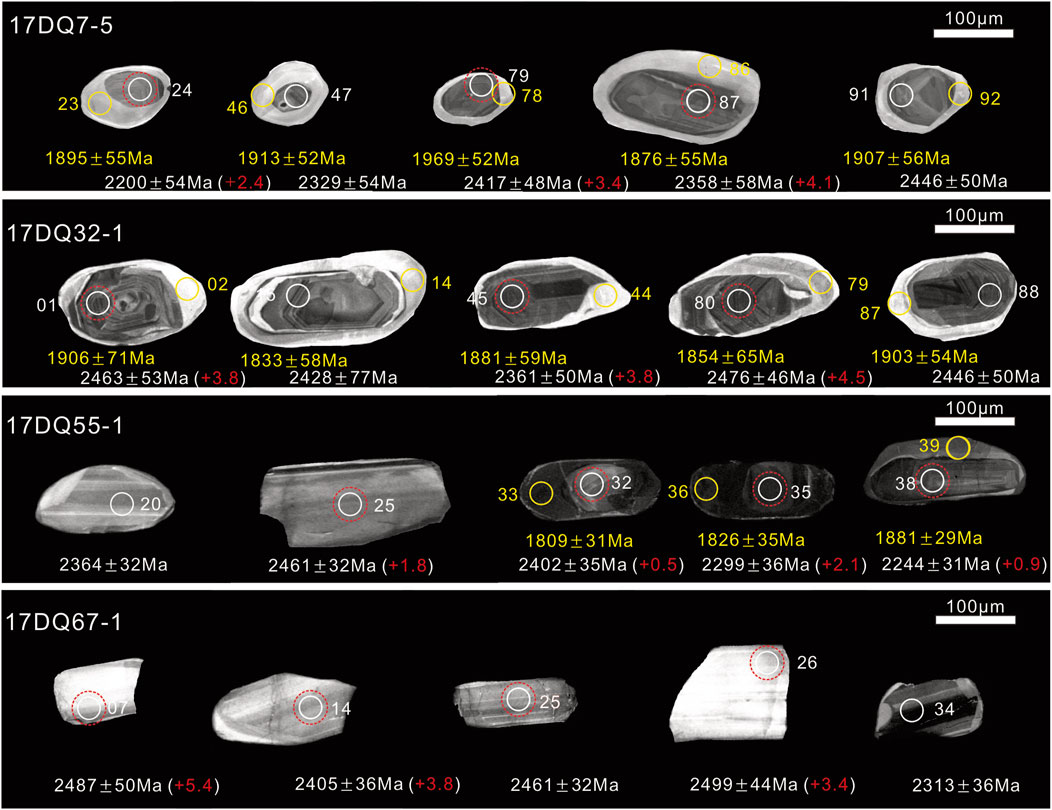
Figure 5. Representative selection of Cathodoluminescence (CL) images for the meta-mafic and felsic rock assemblages (Modified after Wang et al., 2021).
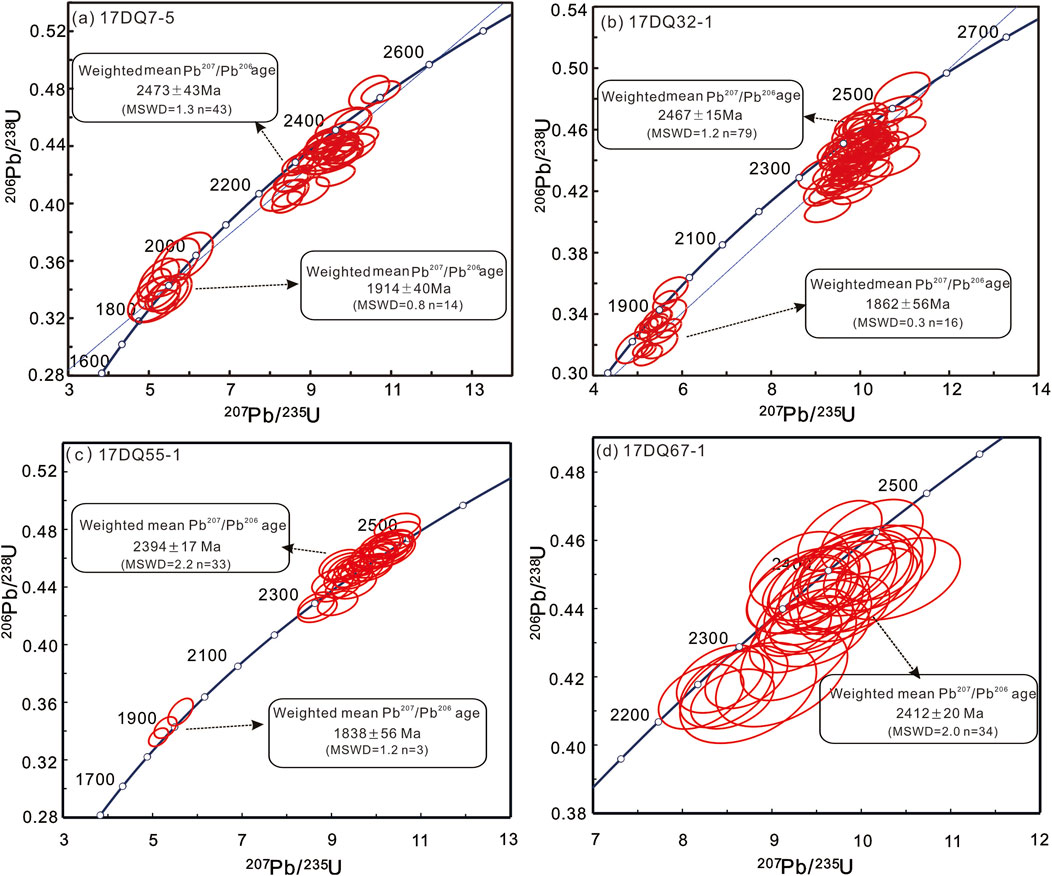
Figure 6. Zircon U-Pb Concordia diagrams of the meta-mafic and felsic rock assemblages from the Daqingshan Complex (Modified after Wang et al., 2021). (a) 17DQ7-5, (b) 17DQ32-1, (c) 17DQ55-1, (d) 17DQ67-1.
Sample 17DQ7-5, represented of the biotite plagiogneiss, was chosen for Lu-Hf isotopic analysis. Twenty-one zircons yield 176Hf/177Hf isotopic compositions ranging from 0.281305 to 0.281446, initial 176Hf/177Hf ratios between 0.281269 and 0.281424. The results yield εHf(t) values ranging from +2.4 to +7.8 (Figure 7a) and depleted-mantle two-stage zircon Hf model ages (TDMC) of 2,835 to 2,503 Ma (Figure 7b). Twenty-one zircons from the biotite plagiogneiss sample (17DQ32-1) have 176Hf/177Hf isotopic compositions dominantly between 0.281311 and 0.281474, initial 176Hf/177Hf ratios ranging from 0.281284 to 0.281462 (Supplementary Table S2). Their εHf(t) values and depleted-mantle two-stage zircon Hf model ages (TDMC) are of +2.7 to +9.1 (Figure 7a) and 2,808 to 2,419 Ma (Figure 7b), respectively. Thirty zircons from the plagioclase amphibolite sample (17DQ55-1) yield 176Hf/177Hf isotopic compositions ranging from 0.281285 to 0.281536, initial 176Hf/177Hf ratios between 0.281263 and 0.281527 (Supplementary Table S2). The data show εHf(t) values in the range of +0.3 to +9.7 (Figure 7a) and depleted-mantle two-stage zircon Hf model ages (TDMC) of 2,899 to 2,428 Ma (Figure 7b). The 176Hf/177Hf isotopic compositions of thirty zircon grains from the plagioclase amphibolite (17DQ67-1) are mainly concentrated between 0.281277 and 0.281432 (Supplementary Table S2). The initial 176Hf/177Hf ratios scatter between a range of 0.281234–0.281395 (Supplementary Table S2). The data yield εHf(t) values ranging from −0.3 to +5.4 (Figure 7a) and the depleted-mantle two-stage zircon Hf model ages (TDMC) of 2,951 to 2,616 Ma (Figure 7b).
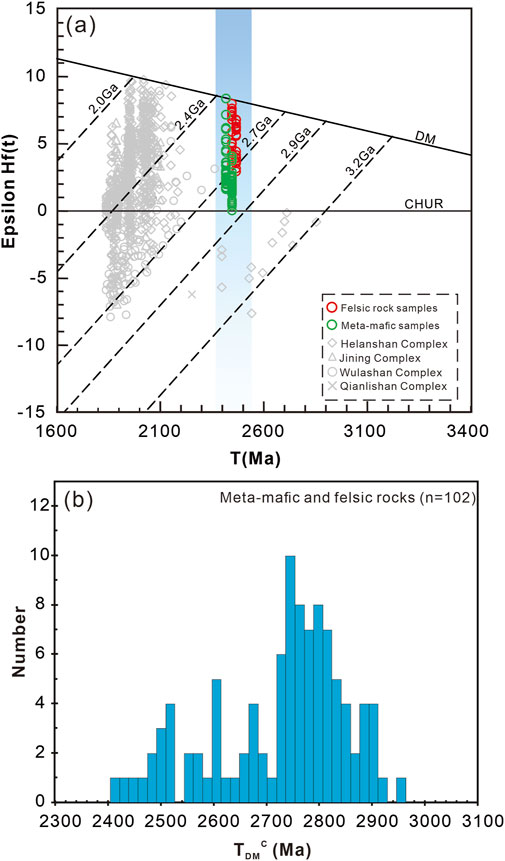
Figure 7. (a) Zircon εHf(t) vs U-Pb age diagram for the meta-mafic and felsic rock assemblages from the Daqingshan Complex. (b) Depleted-mantle two-stage zircon Hf model ages of the meta-mafic and felsic rock assemblages.
5 Discussions
5.1 Significance of the geochronology
Previous geochronological studies have been carried out on the Archean to Paleoproterozoic basement rocks in the Daqingshan Complex. Dan et al. (2012) proposed detrital zircon U-Pb and Hf isotopic analyses to infer a 2.18–2.00 Ga continental arc as a source for the Khondalite Series protoliths. Dong et al. (2014) obtained SHRIMP detrital zircon U-Pb ages of 2.55–2.50 Ga, and two-stage metamorphic zircon ages of 2.45–2.40 and 1.95–1.90 Ga, suggesting that the rocks were deposited at ca 2.55–2.50 Ga and metamorphosed at 2.45–2.40 and 1.95–1.90 Ga. Liu et al. (2017a) suggested that the granitoid rocks were emplaced at ca 2.50–2.45 Ga, and underwent multi-stage metamorphism at ca 2.50–2.45 and 1.95–1.90 Ga in the Daqingshan-Wulashan Complex, which form in a subduction-related magmatic arc. Wang et al. (2020) reported two periods of magmatic activities in the Daqingshan Complex, which occurred at 2.42–2.35 Ga and 1.95–1.88 Ga, respectively. In addition, Wang et al. (2018), Wang et al. (2022) reported that the metamorphic age of the meta-mafic rocks from the Erdaowa Group is 1.95–1.85 Ga. Meanwhile, an increasing number of geochronological studies have revealed that the Daqingshan Complex underwent regional high-grade metamorphism from 1.9 to 1.85 Ga (Liu et al., 2014; Liu et al., 2017b).
In this study, the 207Pb/206Pb weighted mean ages of the meta-mafic and felsic rock assemblages in Daqingshan Complex are 2,473 ± 43 Ma, 2,467 ± 15 Ma, 2,394 ± 17Ma, and 2,412 ± 20 Ma, respectively, and the magmatic zircon ages are concentrated upon 2.47–2.39 Ga (Supplementary Table S1; Figure 6). The 207Pb/206Pb metamorphic zircons yield ages of 1914 ± 40 Ma, 1862 ± 56 Ma, and 1836 ± 56 Ma, respectively, and the magmatic zircon ages are concentrated in 1.91–1.83 Ga (Figure 6; Wang et al., 2021). The results are consistent with the previous studies of the Daqingshan Complex. Combined with the results of previous works, the zircon U-Pb dating results of the meta-mafic and felsic rock assemblages in Daqingshan Complex show that the magmatic activities occurred at 2.47–2.39 Ga, and metamorphic events occurred at 1.91–1.83 Ga (Wan et al., 2013; Liu et al., 2014; Liu et al., 2017b; Wang et al., 2018; Wang et al., 2021).
5.2 Regional crustal evolution
The zircon Hf isotopic data can provide an effective method to determine magmatic sources and petrogenetic processes, constraining the history of crustal growth (Wu et al., 2007). The Paleoproterozoic crustal evolution of the KB has been hotly debated for a long period. Therefore, we present Hf isotopic analysis of zircons from the published meta-mafic and felsic rock assemblages in the Daqingshan Complex (Wang et al., 2021), mainly focusing on the magmatic zircon cores. The crystallization age of the protolith is used to initialize the εHf(t) values. Meanwhile, calculating the model age is helpful to clarify the origin of the parent magma, explain the timing related to crust-mantle differentiation, and understand the process of crustal growth.
As shown in Figure 7a, the meta-mafic and felsic rock assemblages of this study and previously published data of the KB show variable εHf(t) values. The ca. 2.47 Ga zircons from the meta-mafic rock assemblage display a negative εHf(t) value as low as −0.3 (Supplementary Table S2; Figure 7a), while a significant number of zircon grains have positive εHf(t) values as high as + 9.7 (Supplementary Table S2; Figure 7a), and their depleted-mantle two-stage zircon Hf model ages cluster around 2.8–2.6 Ga, suggesting that the primary magma originated from partial melting of the depleted lithospheric mantle. All the ca. 2.47 Ga zircons from the felsic rock assemblage have positive εHf(t) values (+2.4-+9.1; Supplementary Table S2; Figure 7a), and their depleted-mantle two-stage zircon Hf model ages also cluster around 2.8–2.6 Ga (Figure 7b), indicating a juvenile crustal source, formed at ca. 2.8–2.6 Ga. The Hf isotopic analyses of the meta-mafic and felsic rock assemblages in Daqingshan Complex generally fall between the 2.9 Ga crustal evolution line and the depleted mantle line (Figure 7a). Their corresponding Hf model age are close to the diagenetic age of the rocks and the zircon Hf isotopic compositions vary considerably, indicating the possible incorporation of a small amount of mantle-derived material. As mentioned above, these rock assemblages are derived from the depleted lithospheric mantle and the juvenile continental crust sources, and their Hf isotopic compositions exhibit significant variations at the same time, indicating that the mantle-derived or juvenile continental crust materials probably coexisted with the ancient continental crust sources. The diversity of the composition is mainly attributed to magmatism in the island arc environment (Kröner et al., 2014).
Meanwhile, a significant number of zircons Hf isotopic analyses have been conducted on the rocks in KB (Ma et al., 2012; Dong et al., 2014; Liu J. H. et al., 2017; Ouyang et al., 2020; Wang et al., 2022). The data of the granitic rocks yield εHf(t) values ranging from −0.7 to +9.75 and the depleted-mantle two-stage zircon Hf model ages (TDMC) of 2.9 to 2.6 Ga (Liu P. H. et al., 2017; Ouyang et al., 2020; Wang et al., 2022). In addition, the εHf(t) values of zircons derived from meta-volcanic rocks scatter between a range of +0.27 to +7.0, with depleted-mantle two-stage zircon Hf model ages (TDMC) ranging from 2.84 to 2.60 Ga (Ma et al., 2012; Dong et al., 2014). To summarize, the εHf(t) values are predominantly positive, indicating that most of the rocks in KB mainly represent the magmatic products regenerated by the juvenile continental crust.
5.3 Tectonic implications for the KB
Currently, the prevailing viewpoint suggests that the KB is a result of continent-continent collisional belt (Zhao and Zhai, 2013). At about 1.95–1.85 Ga, the southern margin of the Yinshan Block was amalgamated with the northern margin of the Ordos Block (Zhao et al., 2002; Zhao et al., 2005; Yin et al., 2009; Yin et al., 2011). However, there are still some controversies about the events of subduction and crustal accretion processes prior to the collision. As mentioned above, the Daqingshan Complex is in the central part of the KB (Figure 2). Among the Daqingshan Complex, Liu et al. (2014) studied the metamorphic volcanic rocks, and their magmatic ages were mainly concentrated in 2.50–2.45 Ga and 2.30–2.10 Ga, indicating that the KB subducted along the active continental margin arc during the late Neoarchean period. Liu et al. (2017a) investigated the granites and mafic rocks from the Daqingshan Complex, revealing the magmatic ages are mainly concentrated in 2.50–2.45 Ga, and multi-stage metamorphism occurs in 2.50–2.45 Ga and 1.95–1.90 Ga respectively, which was associated to the long-term arc-continent accretion along the southern margin of the Yinshan Block during the late Neoarchean to Paleoproterozoic. Meanwhile, Wang et al. (2020), Wang et al. (2021) focused on the late Neoarchean to Paleoproterozoic granitic gneiss and metamorphic volcanic rocks in the Daqingshan Complex, and concluded that the initial oceanic lithosphere subduction operated along the southern margin of the Yinshan Block at 2.55–2.35 Ga, and the final collision between the Yinshan and Ordos Blocks occurred at 1.95–1.85 Ga. The geochemical characteristics of the 2.47–2.39 Ga felsic and meta-mafic rocks from the Daqingshan Complex further indicate that they are quasi-aluminous to weakly peraluminous nature and belong to the high potassium-calc-alkaline series. These rocks exhibit relative enrichments of large ion lithophile elements (LILEs) such as Rb, Ba, and Nd, and relative depletions of high field strength elements (HFSEs) including Nb, Ta, and Ti. This evidence also supports that they are related to the magmatic arcs associated with subduction (Wang et al., 2021).
In this study, the εHf(t) values of the meta-mafic and felsic rock assemblages in Daqingshan Complex exhibit significant variations (Figure 7a), and the variation of the TDMC is also extensive (Figure 7b), which also supports the island arc magmatism. Furthermore, according to the study of trace element, the meta-mafic and felsic rock assemblages indicate a link between the continental arcs and arc-related/orogenic (Supplementary Table S3; Figure 8). Our new results, combined with the previous studies of the geochronology and geochemistry, indicate that the KB underwent long-term arc-continent accretion along the southern margin of the Yinshan Block during the Neoarchean-Paleoproterozoic, and terminative continent-continent collision of the Yinshan and Ordos Blocks at ca 1.95–1.85 Ga.
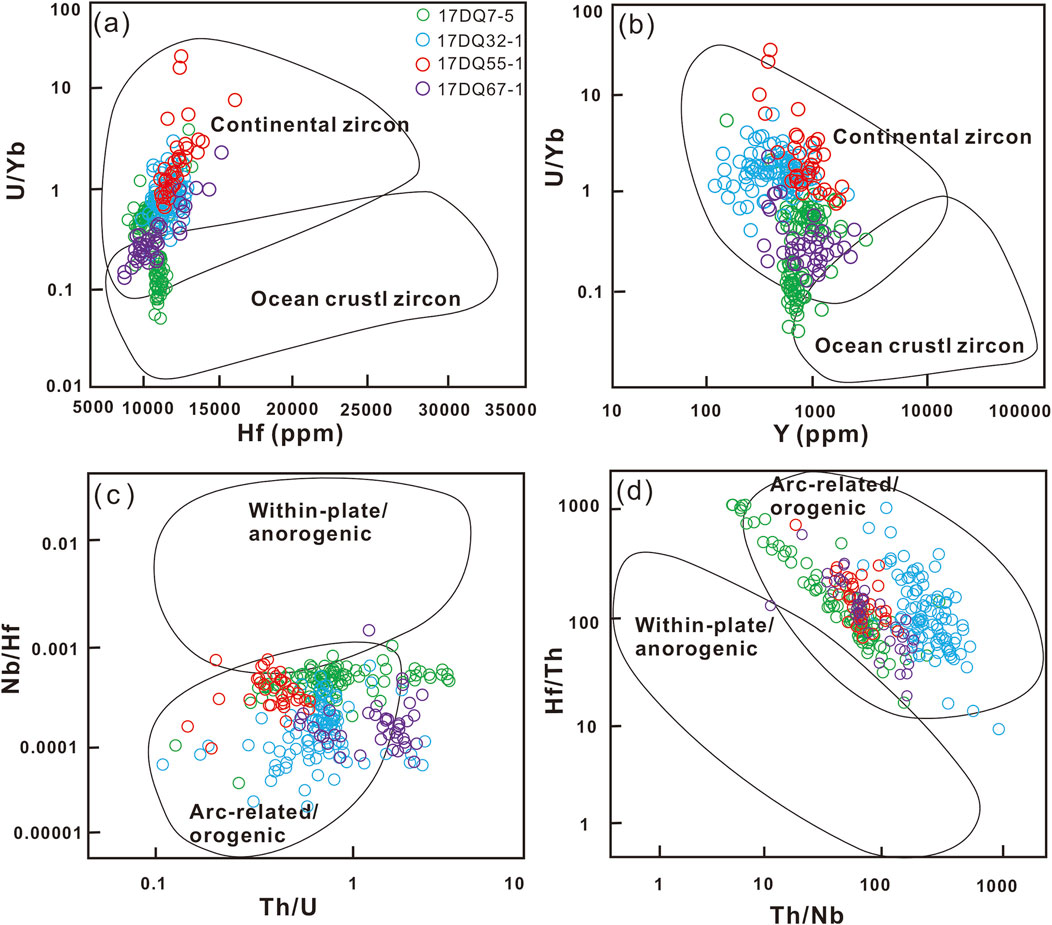
Figure 8. The diagrams of zircon trace element discrimination: (a) U/Yb vs Hf; (b) U/Yb vs Y; (c) Nb/Hf vs Th/U; (d) Hf/Th vs Th/Nb.
6 Conclusion
(1) The zircon Lu-Hf isotopic composition indicates that the protoliths of the 2.47–2.39 Ga meta-mafic and felsic rock assemblages in the Daqingshan Complex originate from depleted lithospheric mantle and/or juvenile continental crust.
(2) The trace element characteristics of zircons from the meta-mafic and felsic rock assemblages indicate that they were formed in the continental arc-related/orogenic tectonic setting.
(3) The Khondalite Belt experienced long-term arc-continent accretion along the southern margin of the Yinshan Block during the late Neoarchean to Paleoproterozoic.
Data availability statement
The original contributions presented in the study are included in the article/Supplementary Material, further inquiries can be directed to the corresponding authors.
Author contributions
HW: Writing – original draft. JC: Data curation, Writing – original draft. NZ: Writing – review and editing. XZ: Writing – review and editing. WK: Writing – original draft, Methodology. BM: Methodology, Writing – original draft.
Funding
The author(s) declare that financial support was received for the research and/or publication of this article. This research was financially supported by the Natural Science Foundation of Shandong Province, China (ZR2022QD028), and the National Natural Science Foundation of China (42402065).
Conflict of interest
The authors declare that the research was conducted in the absence of any commercial or financial relationships that could be construed as a potential conflict of interest.
Generative AI statement
The author(s) declare that no Generative AI was used in the creation of this manuscript.
Publisher’s note
All claims expressed in this article are solely those of the authors and do not necessarily represent those of their affiliated organizations, or those of the publisher, the editors and the reviewers. Any product that may be evaluated in this article, or claim that may be made by its manufacturer, is not guaranteed or endorsed by the publisher.
Supplementary material
The Supplementary Material for this article can be found online at: https://www.frontiersin.org/articles/10.3389/feart.2025.1632499/full#supplementary-material
References
Dan, W., Li, X. H., Guo, J. H., Liu, Y., and Wang, X. C. (2012). Integrated in situ zircon U-Pb age and Hf-O isotopes for the Helanshan khondalites in North China Craton: juvenile crustal materials deposited in active or passive continental margin. Precambrian Res. 222-223, 143–158. doi:10.1016/j.precamres.2011.07.016
Dong, C. Y., Wan, Y. S., Wilde, S. A., Xu, Z. Y., Ma, M. Z., Xie, H. Q., et al. (2014). Earliest paleoproterozoic supracrustal rocks in the North China craton recognized from the daqingshan area of the khondalite belt: constraints on craton evolution. Gondwana Res. 25 (4), 1535–1553. doi:10.1016/j.gr.2013.05.021
Guo, J. H., Sun, M., and Zhai, M. G. (2005). Sm-Nd and SHRIMP U-Pb zircon geochronology of high-pressure granulites in the Sanggan area, North China Craton: timing of Paleoproterozoic continental collision. J. Asian Earth Sci. 24, 629–642. doi:10.1016/j.jseaes.2004.01.017
Jiao, S. J., Guo, J. H., Harley, S. L., and Peng, P. (2013). Geochronology and trace element geochemistry of zircon, monazite and garnet from the garnetite and/or associated other high-grade rocks: implications for Palaeoproterozoic tectonothermal evolution of the Khondalite Belt, North China Craton. Precambrian Res. 237, 78–100. doi:10.1016/j.precamres.2013.09.008
Jiao, S. J., Guo, J. H., Wang, L. J., and Peng, P. (2015). Short-lived high-temperature prograde and retrograde metamorphism in Shaerqin sapphirine-bearing metapelites from the Daqingshan terrane, North China Craton. Precambrian Res. 269, 31–57. doi:10.1016/j.precamres.2015.08.002
Kröner, A., Hoffman, J. E., Xie, H. Q., Münker, C., Hegner, E., Wan, Y. S., et al. (2014). Generation of early Archaean grey gneisses through melting of older crust in the eastern Kaapvaal craton, southern Africa. Precambrian Res. 255, 823–846. doi:10.1016/j.precamres.2014.07.017
Kusky, T. M., and Li, J. H. (2003). Paleoproterozoic tectonic evolution of the North China craton. J. Asian Earth Sci. 22 (4), 383–397. doi:10.1016/s1367-9120(03)00071-3
Li, W. X., Yin, C. Q., Lin, S. F., Li, W. J., Gao, P., Zhang, J., et al. (2022). Paleoproterozoic tectonic evolution from subduction to collision of the khondalite belt in North China: evidence from multiple magmatism in the qianlishan Complex. Precambrian Res. 368, 106471. doi:10.1016/j.precamres.2021.106471
Liu, J. H., Liu, F. L., Ding, Z. J., Liu, P. H., Chen, J. Q., Liu, C. H., et al. (2017a). Late neoarchean–paleoproterozoic arc-continent accretion along the khondalite belt, western Block, North China craton: insights from granitoid rocks of the daqingshan–wulashan area. Precambrian Res. 303, 494–519. doi:10.1016/j.precamres.2017.06.006
Liu, P. H., Liu, F. L., Cai, J., Liu, C. H., Liu, J. H., Wang, F., et al. (2017b). Spatial distribution, P-T-t paths, and tectonic significance of high-pressure mafic granulites from the Daqingshan-Wulashan Complex in the Khondalite Belt, North China Craton. Precambrian Res. 303, 687–708. doi:10.1016/j.precamres.2017.09.004
Liu, P. H., Liu, F. L., Liu, C. H., Liu, J. H., Wang, F., Xiao, L. L., et al. (2014). Multiple mafic magmatic and high-grade metamorphic events revealed by zircons from meta-mafic rocks in the Daqingshan-Wulashan Complex of the Khondalite Belt, North China Craton. Precambrian Res. 246, 334–357. doi:10.1016/j.precamres.2014.02.015
Lu, L. Z., Xu, X. C., and Liu, F. L. (1996). Early precambrian khondalite series in North China. Changchun: Changchun Publishing House.
Ma, M. Z., Wan, Y. S., Santosh, M., Xu, Z. Y., Xie, H. Q., Dong, C. Y., et al. (2012). Decoding multiple tectonothermal events in zircons from single rock samples: SHRIMP zircon U-Pb data from the late Neoarchean rocks of Daqingshan, North China Craton. Gondwana Res. 22 (3-4), 810–827. doi:10.1016/j.gr.2012.02.020
Ouyang, D. J., Guo, J. H., Liou, P., and Huang, G. Y. (2020). Petrogenesis and tectonic implications of 2.45 Ga potassic A-type granite in the daqingshan area, yinshan Block, North China craton. Precambrian Res. 336, 105435. doi:10.1016/j.precamres.2019.105435
Santosh, M., Liu, D. Y., Shi, Y. L., and Liu, S. J. (2013). Paleoproterozoic accretionary orogenesis in the North China Craton: a SHRIMP zircon study. Precambrian Res. 227, 29–54. doi:10.1016/j.precamres.2011.11.004
Santosh, M., Zhao, D. P., and Kusky, T. M. (2010). Mantle dynamics of the Paleoproterozoic North China Craton: a perspective based on seismic tomography. J. Geodyn. 49 (1), 39–53. doi:10.1016/j.jog.2009.09.043
Wan, Y. S., Xu, Z. Y., Dong, C. Y., Nutman, A., Ma, M. Z., Xie, H. Q., et al. (2013). Episodic Paleoproterozoic (∼2.45, ∼1.95 and ∼1.85Ga) mafic magmatism and associated high temperature metamorphism in the Daqingshan area, North China Craton: SHRIMP zircon U–Pb dating and whole-rock geochemistry. Precambrian Res. 224, 71–93. doi:10.1016/j.precamres.2012.09.014
Wang, X., Li, X. P., and Han, Z. Z. (2018). Zircon ages and geochemistry of amphibolitic rocks from the paleoproterozoic Erdaowa Group in the khondalite belt, North China craton and their tectonic implications. Precambrian Res. 317, 253–267. doi:10.1016/j.precamres.2018.09.005
Wang, X., Li, X. P., Zhang, J., and Schertl, H. P. (2020). Geochemistry, geochronology and evolution of paleoproterozoic granitoid gneisses in the khondalite belt, North China craton. Precambrian Res. 338, 105590. doi:10.1016/j.precamres.2019.105590
Wang, X., Li, X. P., Zhang, J., Zhou, H., and Yin, C. Q. (2022). Paleoproterozoic A1-and A2-type coexisting monzogranites in the daqingshan Complex, khondalite belt, North China craton and its tectonic implications. Precambrian Res. 369 (5), 106518. doi:10.1016/j.precamres.2021.106518
Wang, X., Liu, J., Zhou, H., Liu, X. G., Yu, C. Y., Zhang, S. H., et al. (2025). Petrogenesis and tectonic setting of neoarchean K-rich granitoids in the zhulagou area: implications for the crustal maturation of yinshan Block, western North China craton. Geosystems Geoenvironment 4, 100384. doi:10.1016/j.geogeo.2025.100384
Wang, X., Zhang, J., Liu, J., Zhou, H., Liu, X. G., Zhang, S. H., et al. (2024). Geochemistry and geochronology of the TTG-sanukitoid suite in the Zhulagou area: constraints on the Neoarchean crustal evolution of the western North China Craton. Lithos 478-479, 107636. doi:10.1016/j.lithos.2024.107636
Wang, X., Zhang, J., Liu, Q., Zhou, H., Yin, C. Q., Zhang, S. H., et al. (2023). Petrogenesis and tectonic setting of neoarchean tonalitic-trondhjemitic-granodioritic gneisses in the xiwulanbulang area of the yinshan Block, North China craton. Geol. Soc. Am. Bull. 135 (11–12), 2922–2938. doi:10.1130/B36641.1
Wang, X., Zhang, J., Yin, C. Q., Zhou, H., Liu, J., Zhang, W. X., et al. (2021). An early paleoproterozoic back-arc system along the southern margin of the yinshan Block: evidence from a newly-defined bimodal volcanic sequence in the daqingshan Complex, khondalite belt. Am. J. Sci. 321 (6), 708–738. doi:10.2475/06.2021.03
Wu, F. Y., Li, X. H., Zheng, Y. F., and Gao, S. (2007). Lu-Hf isotopic systematics and their applications in petrology. Acta Petrol. Sin. 23 (2), 185–220.
Xia, X. P., Sun, M., Zhao, G. C., Wu, F. Y., Xu, P., Zhang, J., et al. (2008). Paleoproterozoic crustal growth in the western Block of the North China craton: evidence from detrital zircon Hf and whole rock Sr-Nd isotopic compositions of the khondalites from the jining Complex. Am. J. Sci. 308, 304–327. doi:10.2475/03.2008.05
Xia, X. P., Sun, M., Zhao, G. C., and Luo, Y. (2006). LA-ICP-MS U-Pb geochronology of detrital zircons from the Jining Complex, North China Craton and its tectonic significance. Precambrian Res. 144, 199–212. doi:10.1016/j.precamres.2005.11.004
Xia, X. P., Sun, M., Zhao, G. C., Wu, F. Y., and Xie, L. W. (2009). U–Pb and Hf isotopic study of detrital zircons from the Lüliang khondalite, North China Craton, and their tectonic implications. Geol. Mag. 146, 701–716. doi:10.1017/s0016756809006396
Yin, C. Q., Zhao, G. C., Guo, J. H., Sun, M., Xia, X. P., Zhou, X. W., et al. (2011). U-Pb and Hf isotopic study of zircons of the helanshan Complex: constrains on the evolution of the khondalite belt in the western Block of the North China craton. Lithos 122, 25–38. doi:10.1016/j.lithos.2010.11.010
Yin, C. Q., Zhao, G. C., Sun, M., Xia, X. P., Wei, C. J., Leung, W. H., et al. (2009). LA-ICP-MS U-Pb zircon ages of the qianlishan Complex: constrains on the evolution of the khondalite belt in the western Block of the North China craton. Precambrian Res. 174, 78–94. doi:10.1016/j.precamres.2009.06.008
Zhang, J., Zhao, G. C., Li, S. Z., Sun, M., Chan, L. S., Shen, W. L., et al. (2012). Structural pattern of the wutai Complex and its constraints on the tectonic framework of the Trans-North China orogen. Precambrian Res. 222–223, 212–229. doi:10.1016/j.precamres.2011.08.009
Zhang, J., Zhao, G. C., Li, S. Z., Sun, M., Liu, S. W., Wilde, S. A., et al. (2007). Deformation history of the hengshan Complex: implications for the tectonic evolution of the Trans-North China orogen. J. Struct. Geol. 29, 933–949. doi:10.1016/j.jsg.2007.02.013
Zhang, J., Zhao, G. C., Li, S. Z., Sun, M., Wilde, S. A., Liu, S. W., et al. (2009). Polyphase deformation of the fuping Complex, Trans-North China orogen: structures, SHRIMP U-Pb zircon ages and tectonic implications. J. Struct. Geol. 31, 177–193. doi:10.1016/j.jsg.2008.11.008
Zhai, M., Li, T.-S., Peng, P., Hu, B., Liu, F., and Zhang, Y. (2010). Precambrian key tectonic events and evolution of the North China Craton. Geological Society 338, 235–262. doi:10.1144/sp338.12
Zhao, C., Wang, X., Liu, J., Zhang, J., Chen, J., Zhang, C., et al. (2024). Zircon U-Pb-Hf isotopes and geochemistry of Neoarchean TTG gneisses in the Guyang area of the Yinshan Block: constraints on petrogenesis and tettonic implications. Acta Petrol. Sin. 40 (11), 3465–3483. doi:10.18654/1000-0569/2024.11.08
Zhao, G. C., Cawood, P. A., Wilde, S. A., and Lu, L. Z. (2001). High-pressure granulites (retrograded eclogites) from the Hengshan Complex, North China Craton: petrology and tectonic implications. J. Petrology 42, 1141–1170. doi:10.1093/petrology/42.6.1141
Zhao, G. C., Sun, M., and Wilde, S. A. (2002). Major tectonic units of the North China Craton and their Paleoproterozoic assembly. Sci. China Series D-Earth Sci. 32, 538–549.
Zhao, G. C., Sun, M., Wilde, S. A., and Li, S. Z. (2005). Late archean to paleoproterozoic evolution of the North China craton: key issues revisited. Precambrian Res. 136, 177–202. doi:10.1016/j.precamres.2004.10.002
Zhao, G. C., Wilde, S. A., Cawood, P. A., and Lu, L. (1998). Thermal evolution of Archean basement rocks from the eastern part of the North China craton and its bearing on tectonic setting. Int. Geol. Rev. 40, 706–721. doi:10.1080/00206819809465233
Zhao, G. C., Wilde, S. A., Cawood, P. A., and Lu, L. Z. (2000). Petrology and P-T path of the Fuping mafic granulites: implications for tectonic evolution of the central zone of the North China Craton. J. Metamorph. Geol. 18, 375–391. doi:10.1046/j.1525-1314.2000.00264.x
Keywords: Khondalite Belt, daqingshan complex, meta-mafic and felsic rock assemblages, continental magmatic arc, collision
Citation: Wang H, Chen J, Zhou N, Zhang X, Kong W and Ma B (2025) Zircon Lu-Hf isotopic compositions of the Paleoproterozoic meta-mafic and felsic rock assemblages in the Daqingshan complex: constraints on crustal evolution of the Khondalite Belt, north China Craton. Front. Earth Sci. 13:1632499. doi: 10.3389/feart.2025.1632499
Received: 21 May 2025; Accepted: 02 June 2025;
Published: 26 June 2025.
Edited by:
Chen Zhao, Shenyang Center of China Geological Survey, ChinaCopyright © 2025 Wang, Chen, Zhou, Zhang, Kong and Ma. This is an open-access article distributed under the terms of the Creative Commons Attribution License (CC BY). The use, distribution or reproduction in other forums is permitted, provided the original author(s) and the copyright owner(s) are credited and that the original publication in this journal is cited, in accordance with accepted academic practice. No use, distribution or reproduction is permitted which does not comply with these terms.
*Correspondence: Ningchao Zhou, WmhvdW5jMjAxM0AxNjMuY29t; Xiaoyang Zhang, emhhbmdsc3lyQHNkdXN0LmVkdS5jbg==
 Han Wang1,2
Han Wang1,2 Xiaoyang Zhang
Xiaoyang Zhang